Caring for Clown Killifish: A Guide to These Colorful Nano Gems
Small in size but bursting with personality and color, the Clown Killifish is a living firework in the world of nano aquariums. With their vivid vertical stripes and tail fins that resemble flickering flames, these fish are often mistaken for something out of a watercolor painting. Native to the shallow, shaded waters of West Africa, Clown Killifish are peaceful, surface-dwelling gems that thrive in small tanks when given the right conditions.
Despite their delicate appearance, these fish are surprisingly hardy and easy to care for, making them ideal for both beginners and seasoned aquarists. In this guide, we’ll explore how to bring out the best in your Clown Killifish—from tank setup and diet to breeding tips and tank mates—so you can enjoy their dazzling charm to the fullest.
- Quick Care Stats
- Species Overview
- Appearance
- Tank Requirements
- Tank Setup
- Diet and Feeding
- Tank Mates
- Breeding
- Diseases & Treatment
- Frequently Asked Questions (FAQs)
Quick Care Stats
- Scientific Name: Epiplatys annulatus
- Common Name: Clown Killifish, Rocket Killifish
- Origin: West Africa (Guinea, Liberia, Sierra Leone)
- Max Length: 1.4 inches (3.5 cm)
- Minimum Tank: 5 gallons (19 liters)
- Stocking: 6–8 fish per 5 gallons; compatible with peaceful tankmates
- Temperament: Peaceful, shy
- Feeding: Carnivorous; small live, frozen, or high-quality flake foods
- Breeding: Egg-layer; relatively easy with proper setup
- Habitat: Slow-moving streams, swamps, and marshes
- Tank Setup: Heavily planted, low flow, surface cover
- Active Tank Levels: Top
- Temperature: 73–79°F (23–26°C)
- pH: 6.0–7.0
- Water Hardness: 5–12 dGH
- Lifespan: 2–3 years
Species Overview

Clown Killifish, scientifically known as Epiplatys annulatus, are small, vibrant fish native to the slow-moving, shallow waters of West Africa, particularly in Guinea, Sierra Leone, and Liberia. They inhabit freshwater streams, swamps, and temporary pools in coastal rainforest regions, where dense aquatic vegetation and leaf litter provide ample cover.
The habitat of Clown Killifish is often characterized by low water flow and abundant organic material, such as fallen leaves and roots, which create a rich microecosystem. These environments support a high density of microorganisms and tiny invertebrates, forming the bulk of the killifish’s diet. Their small size, rarely exceeding 3.5 cm, allows them to dart through dense plant cover, evading predators like larger fish and birds. The seasonal nature of some of their habitats, particularly temporary pools that dry up during the dry season, has shaped their adaptability, enabling them to survive in fluctuating conditions by exploiting microhabitats within these fragile ecosystems.
A notable feature of Clown Killifish is their bold coloration, which serves as a signal during courtship displays, particularly in males who flare their fins to attract females. Their behavior is marked by a curious and active nature, often seen hovering near the water’s surface to snatch prey or darting among plants to establish small territories. This territoriality, combined with their ability to leap short distances to escape threats or capture prey, makes them uniquely adapted to their niche. However, their restricted range and dependence on pristine, vegetated waters make them vulnerable to habitat loss from deforestation and agricultural expansion, threatening their delicate ecological balance.
Appearance
Clown Killifish are renowned for their vivid, clown-like banded patterns, which give them their name. Their appearance is characterized by the following features:
Base Color: Their bodies display alternating horizontal bands of dark (black or dark brown) and light (yellow, white, or cream) coloration, creating a bold, striped pattern that spans from head to tail. The contrast is particularly striking in well-maintained tanks with dark substrates.
Fins: Males have semi-transparent fins with vibrant accents of yellow, blue, or red, especially noticeable during courtship or in optimal conditions. Females have plainer, shorter fins with minimal or no coloration, though they retain the banded body pattern.
Body Shape: Their slender, elongated bodies are streamlined for agile movement near the surface. An upturned mouth is a key adaptation for surface feeding, allowing them to efficiently consume small insects, zooplankton, or floating food particles.
Sexual Dimorphism: Males are more colorful, with brighter fin accents and more intense band contrast, making them stand out during displays. Females are slightly duller, with less vibrant bands and shorter fins, but they still exhibit the species’ characteristic pattern.
Size: Clown Killifish grow up to 1.4 inches (3.5 cm), with males typically slightly larger and more robust than females. Their petite size makes them ideal for detailed, small-scale aquascapes.
Additional Notes on Appearance
The vibrancy of their coloration can vary based on water quality, diet, and stress levels. In pristine conditions with a nutrient-rich diet, males may exhibit enhanced red or blue hues in their fins, while poor conditions can dull their appearance. Their delicate, almost translucent bodies allow their internal structure to be faintly visible, adding to their unique aesthetic in planted tanks with natural lighting.
Tank Requirements
A minimum tank size of 5 gallons is suitable for a small group of Clown Killifish, but a 10-gallon tank is ideal for a school of 6–8 fish to promote natural schooling behavior and reduce stress. Stock conservatively to avoid overcrowding, aiming for 1–2 fish per gallon when including compatible tankmates, such as dwarf shrimp (Neocaridina davidi), micro rasboras, or small tetras. Avoid aggressive or larger species that may intimidate or prey on these delicate fish. Maintaining stable water parameters is critical for their health:
- Temperature: 73–79°F (23–26°C)
- pH: 6.0–7.0
- Hardness: 5–12 dGH
- Ammonia/Nitrite: 0 ppm
- Nitrate: <20 ppm
A tight-fitting lid is essential, as Clown Killifish are notorious jumpers and may escape through even small gaps. Regular water testing with a reliable test kit is recommended to ensure stability, with weekly water changes of 10–20% to maintain quality. Avoid sudden changes in water parameters to prevent stress or health issues.
Tank Setup
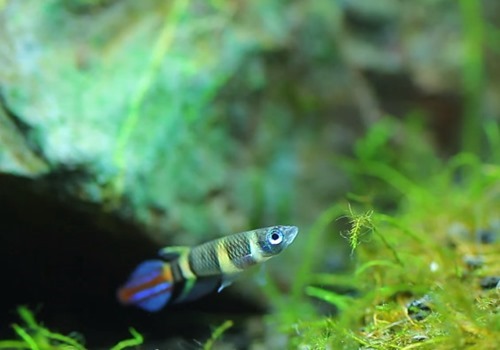
To replicate their natural West African habitat, create a naturalistic environment with dense vegetation and calm water conditions. Use plants like Java moss, Anubias, or floating species such as Amazon frogbit or Salvinia to provide cover and mimic their preference for heavily vegetated waters. Floating plants also diffuse light, creating shaded areas that suit their shy nature. A dark substrate, such as fine gravel or sand, enhances their vivid banded colors and creates a striking visual contrast. Incorporate driftwood, leaf litter (e.g., Indian almond leaves), or small branches to offer hiding spots and add a natural aesthetic, which can also promote beneficial microbial growth.
Use a gentle filtration system, such as a sponge filter or a low-flow hang-on-back filter, to maintain the calm water conditions they prefer, as strong currents can stress them. A reliable aquarium heater is recommended to keep temperatures stable within the ideal range, as fluctuations can impact their health. Subdued or moderate lighting is best, as bright lights may cause stress; floating plants or dimmable LED lights can help achieve the right balance. Ensure the tank is cycled before introducing the fish to avoid ammonia or nitrite spikes.
Diet and Feeding
Clown Killifish are strictly carnivorous, with a natural diet consisting of small insects, zooplankton, and other tiny organisms found at the water’s surface in their native West African habitats. Their upturned mouths are perfectly adapted for surface feeding, making floating or slow-sinking foods ideal. To meet their nutritional needs, offer a varied diet that includes:
- Live Foods: Brine shrimp (newly hatched or adult), daphnia, moina, and micro worms are excellent choices, as they mimic the fish’s natural prey and stimulate active feeding behavior. Live foods also enhance their coloration and vitality.
- Frozen Foods: Frozen brine shrimp, daphnia, or bloodworms are readily accepted and provide a convenient alternative to live foods. Thaw small portions before feeding to ensure they are easily consumed.
- Dry Foods: High-quality micro-pellets or finely crushed flake foods formulated for small carnivorous fish can supplement their diet. Choose products with high protein content and ensure they float or remain near the surface, as Clown Killifish rarely feed from the bottom.
- Feeding Frequency: Feed small portions 1–2 times daily to match their tiny stomachs and prevent overfeeding, which can degrade water quality. A pinch of food that they can consume within 1–2 minutes is sufficient per feeding.
Feeding Tips
- Observe feeding behavior to ensure all fish are eating, as dominant individuals may outcompete shyer ones in a school. If necessary, distribute food across multiple areas of the tank surface.
- Remove uneaten food after a few minutes to prevent fouling the water, especially in smaller tanks where waste accumulates quickly.
- Occasionally offering live foods can encourage natural hunting behaviors and reduce stress, particularly during acclimation or breeding periods.
Maintaining a consistent feeding schedule and a varied diet will keep Clown Killifish healthy, vibrant, and active, with optimal coloration.
Tank Mates
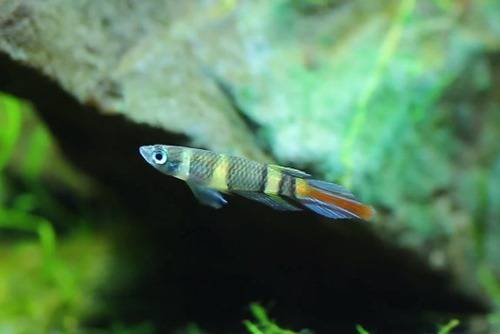
Behavior and Temperament
Clown Killifish are peaceful and slightly shy, thriving best in groups of 6 or more to feel secure and exhibit their natural schooling behavior. They are most active near the water’s surface, where they dart and hover in search of food. When stressed or housed in insufficient numbers, they may become reclusive, hiding among plants or decorations. Males occasionally display mild territorial behaviors, such as flaring their fins or brief chases during courtship, but these interactions are rarely aggressive and do not result in harm. Their calm demeanor makes them an excellent addition to peaceful community tanks, provided tankmates are carefully chosen.
Suitable Tankmates
Clown Killifish do best with small, non-aggressive species that share similar water parameter requirements and do not compete aggressively for food or space. Ideal tankmates include:
- Fish: Small species like neon tetras, ember tetras, chili rasboras, Pygmy corydoras, or Kuhli loaches are excellent companions. These fish occupy different tank levels, reducing competition with the surface-dwelling Clown Killifish.
- Invertebrates: Dwarf shrimp, such as cherry shrimp (Neocaridina davidi) or crystal red shrimp, are compatible and add activity to the tank. Small snails, like nerite snails or Malaysian trumpet snails, are also suitable and help with algae control.
- Avoid: Large, boisterous, or predatory fish (e.g., bettas, cichlids, or larger barbs) that may intimidate or prey on Clown Killifish. Fin-nippers, such as serpae tetras or tiger barbs, should also be avoided, as they may target the killifish’s delicate fins.
Tankmate Considerations
- Ensure the tank is spacious enough to accommodate all inhabitants without overcrowding, adhering to the 1–2 fish per gallon guideline for Clown Killifish and similar-sized tankmates.
- Monitor interactions during the initial introduction, as some tankmates may need time to establish a hierarchy. Provide ample hiding spots and plants to reduce stress and offer retreat areas.
- Avoid housing with other surface-dwelling fish that may compete for food or space, as Clown Killifish are less assertive and may be outcompeted.
Breeding
Preparation for Breeding
Breeding Clown Killifish is relatively straightforward with proper setup and care. Set up a dedicated breeding tank, ideally 5–10 gallons, to control conditions and protect eggs and fry. Include spawning mops, Java moss, or floating plants like Amazon frogbit or Salvinia to provide egg-laying sites, as females prefer to deposit eggs on fine, fibrous surfaces. Maintain optimal water conditions to encourage breeding:
- Temperature: 75–78°F (24–26°C)
- pH: Slightly acidic, around 6.0–6.5
- Hardness: 5–10 dGH
- Water Quality: Ensure ammonia and nitrite levels are 0 ppm, with nitrates below 20 ppm.
Condition the breeding pair or group (one male to two or three females is ideal to reduce male aggression) with high-quality live foods, such as brine shrimp, daphnia, or micro worms, for 1–2 weeks prior to breeding. This enhances their health, vibrancy, and reproductive success. Use a gentle sponge filter to maintain water quality without disturbing eggs or fry, and ensure the tank has a tight lid to prevent jumping.
Breeding
During courtship, males intensify their colors, displaying vibrant yellow, blue, or red fin accents and flaring their fins to attract females. They may perform a dancing motion, swimming in tight circles or zigzags near the female. Females lay small batches of 10–30 eggs daily, attaching them to spawning mops, Java moss, or floating plants. The eggs are adhesive and small, making them easy to overlook. To prevent egg predation, either remove the parents to the main tank after spawning or carefully collect the eggs using a pipette or by transferring the spawning medium to a separate hatching tank. If collecting eggs, place them in a shallow container with water from the breeding tank, ensuring gentle aeration to prevent fungal growth.
Caring for Fry
Eggs typically hatch in 10–14 days at 75°F (24°C), though warmer temperatures (up to 78°F) may speed hatching to as little as 8 days. The fry are extremely tiny and delicate, requiring specialized care:
- Initial Feeding: For the first few days, feed infusoria, paramecium, or commercial liquid/powdered fry food designed for egg-laying fish. After 5–7 days, transition to newly hatched baby brine shrimp or micro worms, which provide essential nutrients for growth.
- Nursery Tank: Maintain a clean, stable nursery tank with the same water parameters as the breeding tank. Perform small, frequent water changes (5–10% daily) using aged, temperature-matched water to avoid shocking the fry. A bare-bottom tank or one with minimal substrate simplifies cleaning.
- Growth and Development: Fry grow slowly, reaching about 0.5 inches (1.2 cm) in 6–8 weeks. As they grow, gradually introduce crushed micro-pellets alongside live foods. Ensure ample hiding spots with fine-leaved plants to reduce stress.
Monitor fry closely for signs of fungal infections or poor growth, and separate larger fry if cannibalism is observed. With proper care, fry can reach juvenile size within 2–3 months and begin displaying their characteristic banded patterns.
Diseases & Treatment
Clown Killifish are generally hardy but sensitive to poor water quality, which can predispose them to common aquarium diseases. Key health issues and treatments include:
Ich (White Spot Disease): Characterized by white spots on the body or fins, lethargy, and rubbing against surfaces. Treat by gradually raising the tank temperature to 80–82°F (27–28°C) for 3–5 days and adding aquarium salt (1 teaspoon per gallon, pre-dissolved) or a commercial ich medication, following the manufacturer’s instructions. Ensure good aeration, as warmer water holds less oxygen. Improve water quality with 25% water changes before and after treatment to prevent recurrence.
Fin Rot: Indicated by frayed, discolored, or deteriorating fins, often caused by bacterial infections linked to poor water quality. Improve water conditions immediately with 20–25% water changes and ensure ammonia/nitrite levels are 0 ppm. Treat with a broad-spectrum antibacterial medication, such as API Furan-2 or Seachem Kanaplex, following dosage instructions. Remove carbon from filters during treatment, and continue for the full course to prevent resistance.
Stress: Symptoms include hiding, faded colors, reduced appetite, or erratic swimming. Stress is often triggered by poor water quality, overcrowding, aggressive tankmates, or sudden parameter changes. Test water parameters and correct any issues (e.g., stabilize pH, reduce nitrates). Minimize tank disturbances by dimming lights, reducing noise, and ensuring ample hiding spots. Check for incompatible tankmates and adjust stocking if necessary.
Prevention
Most health issues can be prevented with proper care:
- Perform regular 20–25% weekly water changes using dechlorinated, temperature-matched water.
- Monitor water parameters weekly with a reliable test kit to maintain stability.
- Avoid overfeeding and remove uneaten food promptly to prevent water fouling.
- Quarantine new fish or plants for 2–4 weeks to prevent introducing pathogens.
- Maintain a stable environment with consistent temperature, lighting, and filtration.
Regular observation of behavior and appearance allows early detection of issues, improving treatment outcomes.
Frequently Asked Questions (FAQs)
Q: Can Clown Killifish live alone?
A: They thrive best in schools of 6 or more, as solitary fish may become stressed, shy, or reclusive, leading to reduced activity and lifespan. Schooling provides security and encourages natural behaviors.
Q: Do they require a heater?
A: Yes, a heater is recommended to maintain stable temperatures between 73–79°F (23–26°C), especially in cooler climates or seasons. Sudden temperature fluctuations can stress or harm the fish.
Q: Are they suitable for beginners?
A: Yes, their small size, hardiness, and relatively simple care requirements make them beginner-friendly, provided water quality is diligently maintained and a suitable tank setup is provided.
Q: What’s the best food for Clown Killifish?
A: Small live foods like brine shrimp, daphnia, or micro worms are ideal, as they mimic their natural diet and promote vibrant colors. Supplement with high-quality micro-pellets or finely crushed flakes formulated for small carnivorous fish, ensuring food floats for their surface-feeding habits.
Q: How long do Clown Killifish live?
A: With proper care, they typically live 2–3 years, though optimal conditions (stable water parameters, varied diet, and low stress) can extend their lifespan to 4 years or more.
Q: Can they breed in a community tank?
A: Breeding is possible in a community tank, but success is limited due to egg predation by tankmates or parents. A dedicated breeding tank with spawning mops and controlled conditions is recommended for higher fry survival rates.
Q: Do Clown Killifish jump often?
A: Yes, they are prone to jumping, especially when startled or during feeding. A tight-fitting lid with no gaps is essential to prevent escapes.

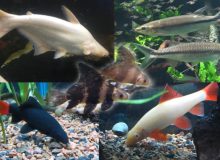
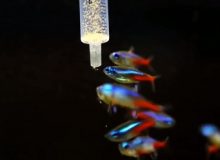
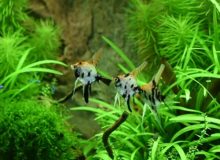
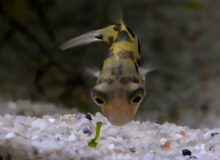
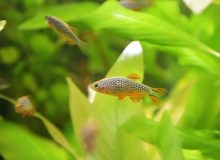
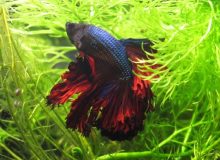
Leave a Reply